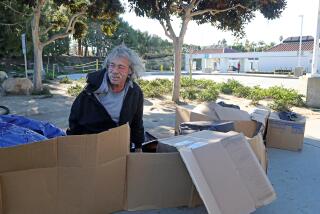Critics Decry Cleanup Plans in Santa Barbara
- Share via
SANTA BARBARA — A package of possible laws aimed at cleaning up neighborhoods in this seaside city is coming under attack for also targeting the homeless.
The laws deal primarily with reducing graffiti, but they also include prohibiting drinking in some small parks where alcohol consumption is now allowed and keeping people from sitting or lying on such structures as news racks along State Street and the city’s historic Stearns Wharf.
Those proposals have touched off alarm from a City Council member and some homeless advocates who are opposed to ordinances that appear to be about neighborhood improvement but are more about clearing the streets of homeless people.
“There is a strong faction on the council that wants to make a better life for the homeless but another that wants to use neighborhood preservation as a way to crack down on the homeless,” said Councilman Das Williams, a leader on both neighborhood improvement and homeless issues.
“We can’t improve a neighborhood by getting rid of the neighbors,” he said.
Councilwoman Helene Schneider, chairwoman of the ordinance committee, said she was concerned that some have interpreted the proposed new laws as being aimed at the homeless. She said it showed how inflammatory the rhetoric about homelessness had become during a time when the problem has grown, locally and nationally.
“The city staff came to us with a set of proposals and we were asked to prioritize them,” Schneider said. “The top one for us was coming up with an anti-graffiti ordinance that will allow us to move faster to paint over graffiti” on public or private buildings.
“We also wanted to focus on the issue of whether to expand nonsmoking areas outside the library and some public buildings, as well as bus stops,” Schneider said. “And we told the staff we want to come up with ways to reduce the number of abandoned shopping carts cluttering up some areas.”
Both Schneider and Councilman Brian Barnwell, another member of the ordinance committee, emphasized that the package of proposals from the city administrator’s office was far from any formal approval.
“My take on it is that these are not just homeless issues, and it’s intellectually dishonest to mix homelessness in with these things,” Barnwell said. “It confuses legitimate homeless issues with problems that are essentially behavior problems. I’m not trying to drive the homeless out of any place. I’m trying to drive crime out.”
Other proposals presented to the ordinance committee earlier this month included adding a code-enforcement officer to help combat blighted housing, outlawing the storing of abandoned cars on private property and generally giving city officials greater power to enforce laws against such property conditions as overgrown vegetation and damaged roofing.
“I really don’t see this as a crackdown at all,” said Robert Pearson, director of the city’s housing authority and a leader of efforts to provide shelter for the homeless. “I think they are exactly what the city staff intended them to be: neighborhood improvement concerns.”
The timing of the city’s proposals may have had something to do with the link to homelessness, Williams said. A pit bull attack on Councilman Barnwell in a blighted area off Milpas Street on Feb. 13 touched off one of the most heated battles over the homeless in recent years.
The scene of the attack was just a few blocks from the city’s largest homeless shelter, which many have blamed for contributing to neighborhood deterioration. Two weeks after the attack, the council warned shelter officials that they would need to establish better relations with the Milpas community.
Since then, business leaders and shelter officials have met every two weeks. Pearson said the sides have made considerable progress in working together.
Before the attack on Barnwell, it was common to see transients drinking malt liquor at gas stations in the Milpas Street area. Since the attack, a police crackdown has attempted to keep those people out of prominent view.
Williams said the success of the Milpas Street group has inspired others to make similar complaints. He said the city’s anti-homeless forces see neighborhood preservation as the best political banner for their cause.
“They are definitely trying to flex their muscles,” Williams said. “This is at a very preliminary stage now, but it could become a serious issue.”
More to Read
Sign up for Essential California
The most important California stories and recommendations in your inbox every morning.
You may occasionally receive promotional content from the Los Angeles Times.










